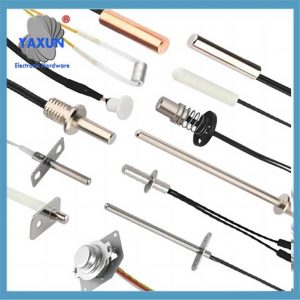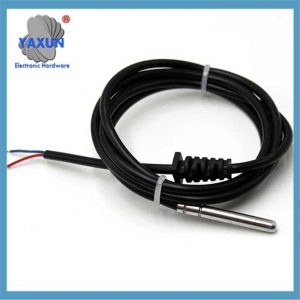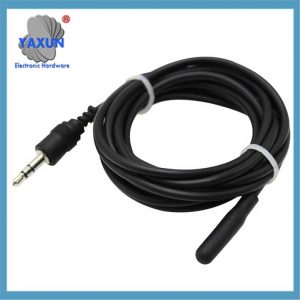CTN (coefficient de température négatif) Le capteur de température est un élément de mesure de la température qui utilise la diminution exponentielle de la résistance d'une thermistance à mesure que la température augmente. Son noyau est un semi-conducteur en céramique fabriqué par des oxydes métalliques de frittage (comme le manganèse, cobalt, et nickel), et la température est déduite en mesurant le changement de résistance. Voici ses caractéristiques techniques de base, candidatures, et points de sélection:
je. Caractéristiques de base
Principe de travail
Lorsque la température augmente, La concentration de support du matériau semi-conducteur s'étend et la valeur de résistance diminue (Caractéristiques des coefficients de température négatifs).
La relation de résistance à la température est conforme à l'équation Steinhart-Hart: R =, où la valeur b (constante) détermine la sensibilité.
Comment ça marche:
Les thermistances NTC utilisent le principe du coefficient de température négatif, où la résistance du matériau diminue à mesure que la température augmente. Cette relation est généralement non linéaire.
Key Paramètres
résistance normale (R25): Résistance de référence à 25 ° C (comme 5kΩ, 10kΩ, 100kΩ).
B Valeur: reflète la sensibilité à la température (Common 3435K, 3950K, etc.), plus la valeur est élevée, Plus la sensibilité est forte.
Thermal Time Constante: indicateur de vitesse de réponse (millisecondes à quelques secondes).
précision: La qualité industrielle peut atteindre ± 0,1 ° C dans la plage de -20 ° C ~ 85 ° C.
Caractéristiques structurelles
Il se compose de puce NTC, coquille de protection (métal / plastique), chefs et terminaux, et adopte le processus d'encapsulation à double couche pour améliorer l'étanchéité et la résistance aux dommages mécaniques.
Taille flexible (diamètre minimum 0.01 pouces), Prise en charge de la conception personnalisée.
Avantages:
Les thermistances NTC sont connues pour leur haute sensibilité aux changements de température, taille compacte, et rentable.
Espèces:
Les thermistances NTC se présentent sous diverses formes, y compris la puce, disque, et versions à baisse, avec chaque formulaire ayant des avantages et des applications différents.
II. Scénarios d'application typiques
Consumer électronique et appareils électroménagers
Contrôle de rétroaction de la température des climatiseurs et réfrigérateurs; Chauffeur d'eau Protection de brûlure anti-sécheuse; Surveillance de la température de l'eau de la machine à laver.
Les véhicules énergétiques et le stockage d'énergie »
Surveillance de la température de la batterie, Protection de surchauffe du moteur (Des emballages à haute température et une conception de dissipation de chaleur forcée sont nécessaires).
Contrôle industriel
Contrôle de température de la machine de moulage par injection, étalonnage de la température du four chauffant, Protection de surchauffe des équipements d'alimentation électrique.
équipement médical
Surveillance de la température du flux d'air du ventilateur, Équipement de dialyse Contrôle de la température liquide, thermomètre numérique.
autres champs
Détection de niveau de liquide (Alarme du niveau d'huile du réservoir d'huile), compensation de température du circuit (dérive du transistor compensant).
III. Guide de sélection
| Facteurs | Points de référence |
| GAMME DE TEMPERATURE | -50℃ ~ 150 ℃ Objectif général; >150℃ nécessite un emballage spécial (comme le scellage en verre). |
| Exigences de précision | Pour les scénarios de haute précision, Sélectionnez des modèles avec la cohérence de la valeur B dans ± 1% et la tolérance R25 ± 1% (comme la série MF53). |
| Adaptabilité environnementale | Pour des environnements humides / corrosifs, Utiliser un emballage étanche en acier inoxydable (comme la sonde 10k3435); Des pistes anti-flexion sont nécessaires dans les situations de vibration. |
| Speed de réponse à la réponse | Lorsque une réponse rapide est requise, sélectionnez un modèle avec une constante de temps thermique de <5s. |
| Circuit Matching | Sélectionnez la valeur R25 en fonction de l'impédance du système (comme 10kΩ est couramment utilisé dans les systèmes 5V). |
Iv. Direction de l'évolution technologique
Innovation matériale: Les copeaux d'électrode en or améliorent la stabilité à haute température (> 200 ℃).
intégration: Combiné avec le module de transmission sans fil pour obtenir une surveillance à distance de l'Internet des objets.
Optimisation de la dissipation de cohétion: La structure de dissipation thermique brevetée aide les moteurs de véhicules électriques à fonctionner de manière fiable dans des environnements à haute température.
Note: Les capteurs NTC doivent être évités à une température ultra-bas (< -50 ℃) ou une température ultra-élevée (> 300 ℃) scénarios. Pour de telles conditions, il est recommandé d'utiliser des thermocouples (Type K) ou rtd410.
 English
English Afrikaans
Afrikaans العربية
العربية বাংলা
বাংলা bosanski jezik
bosanski jezik Български
Български Català
Català 粤语
粤语 中文(简体)
中文(简体) 中文(漢字)
中文(漢字) Hrvatski
Hrvatski Čeština
Čeština Nederlands
Nederlands Eesti keel
Eesti keel Suomi
Suomi Français
Français Deutsch
Deutsch Ελληνικά
Ελληνικά हिन्दी; हिंदी
हिन्दी; हिंदी Magyar
Magyar Bahasa Indonesia
Bahasa Indonesia Italiano
Italiano 日本語
日本語 한국어
한국어 Latviešu valoda
Latviešu valoda Lietuvių kalba
Lietuvių kalba македонски јазик
македонски јазик Bahasa Melayu
Bahasa Melayu Norsk
Norsk پارسی
پارسی Polski
Polski Português
Português Română
Română Русский
Русский Cрпски језик
Cрпски језик Slovenčina
Slovenčina Slovenščina
Slovenščina Español
Español Svenska
Svenska ภาษาไทย
ภาษาไทย Türkçe
Türkçe Українська
Українська اردو
اردو Tiếng Việt
Tiếng Việt



